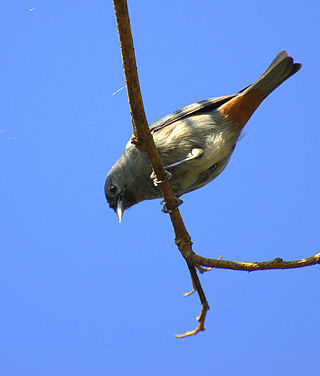Conirostrum
Genus of birds From Wikipedia, the free encyclopedia
Typical conebills belong to the tanager genus Conirostrum. They are small tanagers (9–14 cm) found in the forests of South America. They feed in pairs or small flocks by gleaning insects from foliage.
| Conebills | |
|---|---|
 | |
| Chestnut-vented conebill (Conirostrum speciosum) | |
| Scientific classification | |
| Domain: | Eukaryota |
| Kingdom: | Animalia |
| Phylum: | Chordata |
| Class: | Aves |
| Order: | Passeriformes |
| Family: | Thraupidae |
| Genus: | Conirostrum d'Orbigny & Lafresnaye, 1838 |
| Type species | |
| Conirostrum cinereum d'Orbigny & Lafresnaye, 1838 | |
| Species | |
|
See text | |
The genus consists of two rather distinct subgenera:[1] The first, Ateleodacnis, possibly deserving full generic status, is confined to lowland areas. They are mostly grey in colour and inhabit deciduous woodlands, mangroves or riverbank habitats. The second group, the nominate Conirostrum subgenus, inhabits the forests of the Andes. They are somewhat more colourful combining grey or blue backs with rufous underparts. Their thin bills led to them being formerly classified as wood-warblers or honeycreepers but genetic data places them in the tanager family Thraupidae.[2]
Taxonomy and species list
Summarize
Perspective
The genus Conirostrum was introduced in 1838 by the French naturalists Alcide d'Orbigny and Frédéric de Lafresnaye with the cinereous conebill (Conirostrum cinereum) as the type species.[3][4] The genus name combines the Latin conus meaning "cone" and rostrum meaning "bill".[5] There are now 11 species placed in the genus.[6]
| Image | Common name | Scientific name | Distribution |
|---|---|---|---|
 |
Pearly-breasted conebill | Conirostrum margaritae | Brazil and Peru |
 |
Bicolored conebill | Conirostrum bicolor | Colombia, Venezuela and Trinidad south and east to the Guianas, northeast Peru and Brazil |
 |
Chestnut-vented conebill | Conirostrum speciosum | Argentina, Bolivia, Brazil, Colombia, Ecuador, French Guiana, Guyana, Paraguay, Peru, Suriname, and Venezuela |
 |
White-eared conebill | Conirostrum leucogenys | Colombia, Panama, and Venezuela |
 |
Capped conebill | Conirostrum albifrons | Bolivia, Colombia, Ecuador, Peru, and Venezuela |
 |
Giant conebill | Conirostrum binghami (formerly Oreomanes fraseri) | Colombia to Ecuador, and Peru to Bolivia |
 |
Blue-backed conebill | Conirostrum sitticolor | Bolivia, Colombia, Ecuador, Peru, and Venezuela. |
 |
White-browed conebill | Conirostrum ferrugineiventre | Bolivia and Peru |
 |
Tamarugo conebill | Conirostrum tamarugense | northern Chile and is a vagrant to southern Peru |
 |
Rufous-browed conebill | Conirostrum rufum | Colombia and far western Venezuela |
 |
Cinereous conebill | Conirostrum cinereum | Bolivia, Chile, Colombia, Ecuador, and Peru. |
References
Wikiwand - on
Seamless Wikipedia browsing. On steroids.
